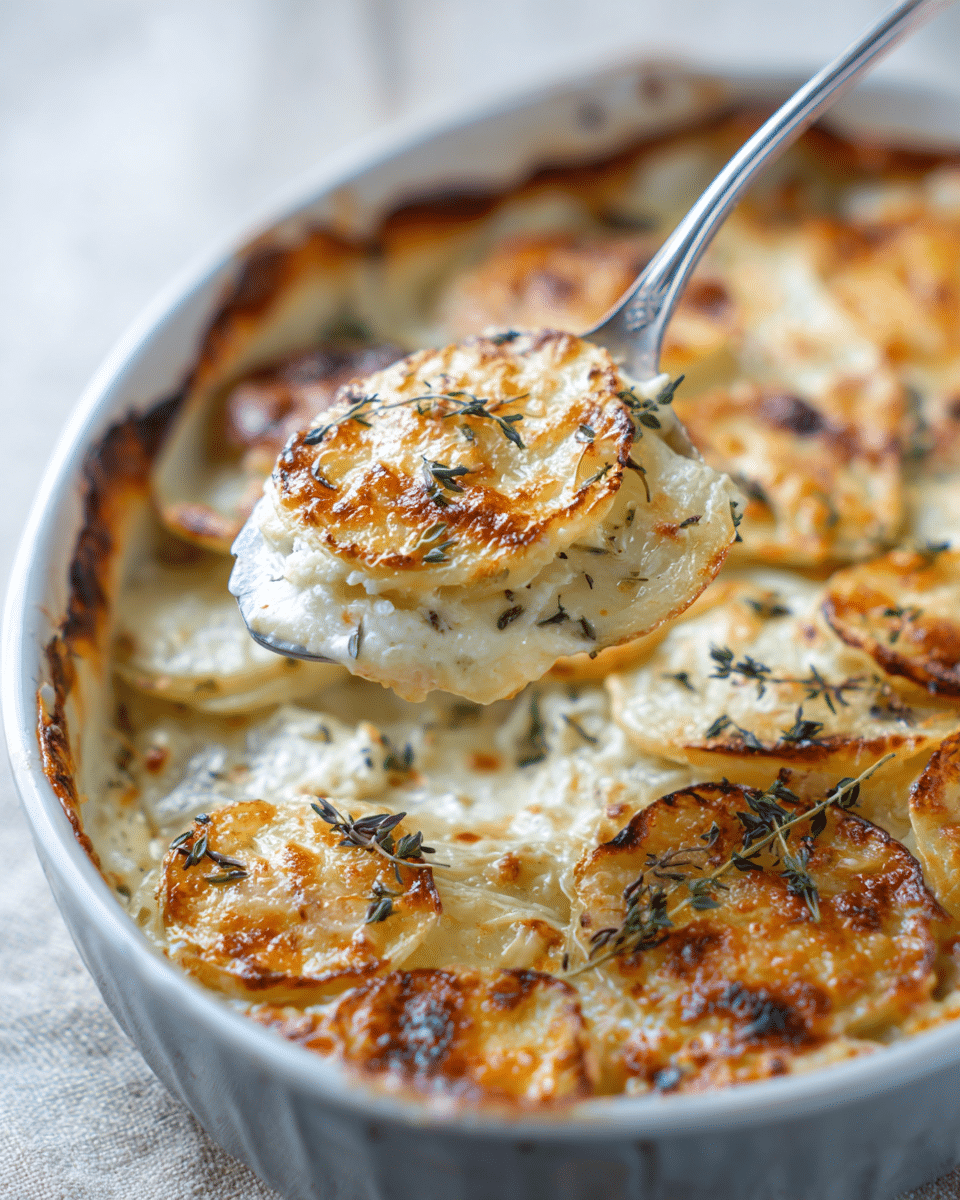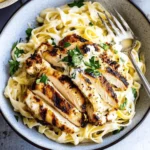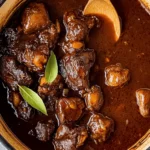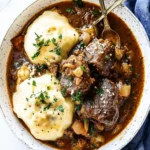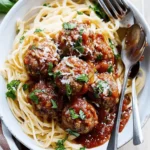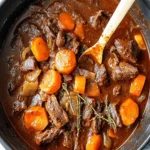Cheesy Kohlrabi Gratin is a rich, creamy, and low-carb alternative to traditional potato-based gratins. Kohlrabi, a versatile and mildly sweet vegetable, becomes incredibly tender and flavorful when baked in a cheesy, garlicky cream sauce. This gratin is the perfect comfort food for those looking to reduce carbs without sacrificing indulgent taste. It makes a fantastic side dish for roasted meats or a satisfying vegetarian main course.
FULL RECIPE
Ingredients
- 2 medium kohlrabi bulbs, peeled and thinly sliced
- 1 tablespoon butter
- 1 clove garlic, minced
- 1 cup heavy cream
- 1/2 cup grated Parmesan cheese
- 1 cup shredded Gruyère cheese (or mozzarella for milder flavor)
- 1/2 teaspoon salt
- 1/4 teaspoon black pepper
- 1/4 teaspoon ground nutmeg (optional)
- 1 tablespoon chopped fresh thyme or parsley (optional, for garnish)
Directions
- Preheat your oven to 375°F (190°C).
- In a small saucepan, melt the butter over medium heat and sauté the minced garlic for 1 minute until fragrant.
- Add the heavy cream, salt, pepper, and nutmeg. Bring to a gentle simmer and stir in the Parmesan cheese. Let the sauce thicken slightly, then remove from heat.
- In a greased baking dish, layer half of the sliced kohlrabi.
- Pour half of the cream mixture over the kohlrabi and sprinkle with half of the shredded Gruyère cheese.
- Repeat with the remaining kohlrabi, cream sauce, and Gruyère.
- Cover the dish with foil and bake for 30 minutes.
- Remove foil and bake for an additional 20–25 minutes, or until the top is golden brown and the kohlrabi is tender.
- Let it rest for 5 minutes before serving. Garnish with fresh herbs if desired.
Nutrition Facts
- Calories: 280 kcal
- Carbohydrates: 8 g
- Dietary Fiber: 3 g
- Sugars: 3 g
- Total Fat: 24 g
- Saturated Fat: 15 g
- Protein: 9 g
- Sodium: 350 mg
- Cholesterol: 70 mg
- Calcium: 200 mg
What Makes Kohlrabi a Smart Low-Carb Choice
Kohlrabi is a standout ingredient for anyone following a low-carb lifestyle. With just about 6 grams of carbohydrates per cup, this bulbous vegetable offers a satisfying, potato-like texture without the glycemic spike. It’s part of the cruciferous vegetable family, like cabbage and broccoli, and shares their health-promoting compounds. In a dish like gratin, where creamy sauces and cheese take center stage, kohlrabi soaks up the flavors beautifully while keeping the carb count manageable. Its subtle sweetness and slight crunch when undercooked make it a versatile substitute in many traditionally starch-heavy recipes.
Flavor Profile and Texture When Baked
When baked in a gratin, kohlrabi transforms from crisp and slightly peppery to soft, mellow, and comforting. Unlike potatoes, which become dense, kohlrabi tends to hold its shape while still becoming tender, offering just the right balance of bite and creaminess. It also readily absorbs surrounding flavors, making it ideal for creamy cheese sauces and aromatic herbs. Its taste is mild enough to not overpower the dish, yet distinct enough to add personality, especially when paired with nutty cheeses like Gruyère or sharp Parmesan.
Cheese Pairings and Their Role in the Gratin
Cheese is a defining feature of any gratin, and in this recipe, a combination of Gruyère and Parmesan delivers depth, richness, and that coveted golden crust. Gruyère melts exceptionally well, offering a creamy texture and slightly nutty flavor. Parmesan adds sharpness and saltiness while enhancing the savory complexity. You can substitute or blend other cheeses such as aged cheddar, Swiss, or even blue cheese for stronger flavor variations. The goal is to create a well-balanced profile that highlights the kohlrabi without overpowering its delicate taste.
Health Benefits of the Dish
Beyond its low-carb appeal, this gratin also delivers several nutritional benefits. Kohlrabi is rich in vitamin C, a powerful antioxidant that supports immune health, and provides a good amount of fiber for digestive wellness. The heavy cream and cheese offer calcium and vitamin D, both essential for bone health. While it is high in fat due to the dairy content, the fats are primarily saturated and can be included as part of a balanced keto or low-carb diet. For those aiming to cut refined carbs while still enjoying hearty meals, this dish checks many boxes.
Variations to Suit Different Diets
Cheesy Kohlrabi Gratin can be easily adapted to accommodate dietary preferences or restrictions. For a dairy-free version, opt for coconut cream or cashew cream in place of heavy cream, and use vegan cheese substitutes that melt well. Those following paleo or whole-food diets can use clarified butter (ghee) and skip cheese altogether in favor of nutritional yeast for a cheesy flavor. Herbs like rosemary or thyme can be added for an aromatic twist, and those wanting more vegetables can mix in zucchini, cauliflower, or spinach for a nutrient boost.
Tips for Perfect Layering and Texture
The secret to a perfect gratin lies in how you layer the ingredients and cook them. Thin, uniform slices of kohlrabi ensure even cooking and a consistent bite throughout. Using a mandoline slicer helps achieve precision. To avoid a watery dish, make sure the kohlrabi is patted dry before layering. Par-cooking the cream sauce with garlic and Parmesan beforehand deepens the flavor and helps bind the layers. Covering the dish initially keeps the interior moist, while uncovering it in the final bake allows the top to become bubbly and browned.
Ideal Side Dishes and Pairings
This gratin is incredibly versatile and pairs well with a variety of proteins and sides. It complements roasted chicken, pork chops, or seared salmon beautifully. For a vegetarian meal, serve it alongside a simple green salad with a tangy vinaigrette or some sautéed green beans. The richness of the gratin is balanced well with something acidic or crisp. A light sparkling water with citrus or a dry white wine like Chardonnay also works well to cut through the creamy texture.
How to Store and Reheat Leftovers
Cheesy Kohlrabi Gratin stores quite well, making it a great dish to prepare in advance. After cooling, place leftovers in an airtight container and refrigerate for up to 4 days. To reheat, cover with foil and warm in a 350°F (175°C) oven for 10–15 minutes, or until heated through. If using a microwave, heat in 30-second intervals to avoid drying out the cheese. For longer storage, the gratin can be frozen in single-serving portions for up to 1 month. Let it thaw overnight in the fridge before reheating for best results.
Involving Seasonal Ingredients for Variety
Kohlrabi is usually in season from late fall through spring, but this recipe can be customized year-round with what’s available. In winter, try pairing it with roasted garlic and caramelized onions for warmth and sweetness. Spring versions can include fresh herbs and lemon zest for a lighter flavor. When kohlrabi isn’t available, consider swapping in turnips, rutabaga, or thinly sliced zucchini. Each offers its own unique texture and taste, keeping the recipe fresh and adaptable throughout the year.
Advertisement
Making It a Complete Meal
Although typically served as a side dish, Cheesy Kohlrabi Gratin can be turned into a main course with a few tweaks. Adding cooked, diced bacon, ground turkey, or sautéed mushrooms into the layers adds protein and heartiness. You could also stir in cooked lentils or a layer of sautéed spinach to increase the nutritional value. This way, the gratin becomes a full, one-dish meal that’s both satisfying and nutrient-rich, especially suitable for a cozy weeknight dinner.
Conclusion
Cheesy Kohlrabi Gratin is a delicious and comforting dish that masterfully blends flavor, nutrition, and simplicity. Its low-carb profile makes it a standout for health-conscious eaters, while its creamy, cheesy appeal satisfies comfort food cravings. With its flexible recipe structure, it invites personalization—be it through cheese choices, added vegetables, or protein enhancements.

